| Back to Back Issues Page |
 |
|
Bangkok Travelbug August 15 Muang Sing Historical Park July 29, 2015 |
| Hello
Prasart Muang Sing in brief Prasart Muang Sing, (prasart – abode of the gods, muang – city, sing – lion) a Khmer sanctuary in Kanchanaburi, was probably built in the 13th C, in the latter part of the reign of King Jayavarman VII (1181 – 12?*), reputedly the greatest of the Khmer kings. It’s located at the western extremity of the Khmer Empire based in Angkhor Wat more than 600 km away! It’s like one of the many Khmer sanctuaries located in north-eastern and central Thailand that serve as a places of rest, meditation and prayer for the pilgrims. This historical park, which is all that remains of the sanctuary, is about 45 km from Kanchanaburi city and about 170 km from Bangkok. The sanctuary located in the Sai Yok district in the Khwae Noi valley is about hundred hectares (247 acres) in area and surrounded by a wall and several moats for defence and irrigation. 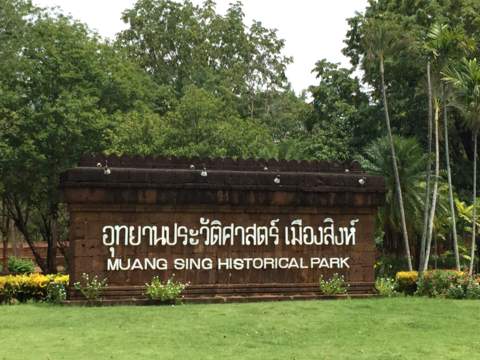
*Note¹ Historians are unclear as to the exact year in which King Jayavarman died. Table of contents Significance of the Khwae Noi valley I’ve often wondered why a Khmer sanctuary is located in this far-flung western corner of the empire, more than 600 km from the centre of power in Angkor Wat. The answer, I think, lies in the Three Pagoda Pass. Mountain ranges in the north and west of Kanchanaburi form an effective barrier between Myanmar and Thailand with the only passage through being the Three Pagoda Pass. These mountains extend south-eastwards and cover more than half the province. Movement in the north-western sector of Kanchanaburi is confined to the Khwae Noi valley and to a lesser extent the Khwae Yai valley. The Khwae Noi valley provides a natural overland passage between Thailand and Indo-China in the east and Myanmar and India to the north-west through the Three Pagoda Pass. A glance at the terrain map of Kanchaburi makes this clear. Map of Khwae Noi valley Click on this link for a bigger map For this reason, the Japanese used the Khwae Noi valley for the construction of the Death Railway in their Burma campaign. During the Burmese-Siamese Wars in the reign of King Rama I (1782 – 1809), the Three Pagoda Pass and the Khwae Noi valley featured prominently in the battle plans of both sides. Major battles were fought in this area. The early Indian scholars, who brought Buddhism to this region, as early as the 3rd C BC, if they came overland, must have passed through this area. Perhaps that’s why in the 13th C, a sanctuary along the Khwae Noi valley would have provided for the pilgrims travelling between these two regions. 
View of the main monument from the north Table of contents Tour of Muang Sing Historical Park Let’s take a tour of the Muang Sing Historical Park which consists of:
Monument 1 As the visitor enters the main entrance through the east gate, he will see Monument 1 straight ahead at the end of a path made up of old stones. 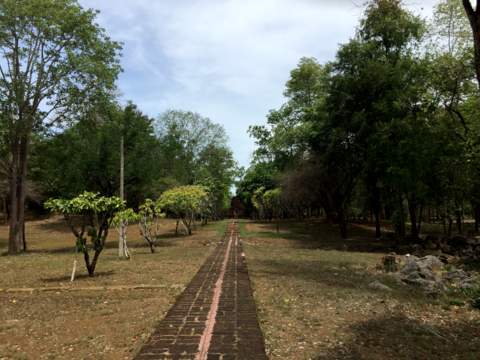
Long walkway leading to Monument 1 in the distance This is the biggest of the four monuments and is the main monument at the heart of the entire sanctuary. It has a prang (rectangular pagoda) in the centre of the enclosure. Not much remains of this central structure and it’s actually over-shadowed by the high arch over the east entrance. 
Monument 1 - the east entrance Within the remains of prang in the centre is a statue of the deity, radiating Bodhisattva Avalokitesvara². 
Radiating Bodhisattva Avalokitesvara There’s an inner wall around the monument with four gates (gopura) on each side of the wall. 
Inner wall around the monument 
Passage to the inside of the monument Here’s a look at the insides of Monument 1 
The inner courtyard 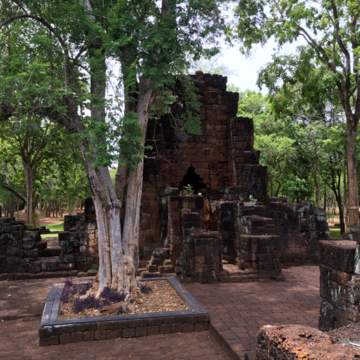
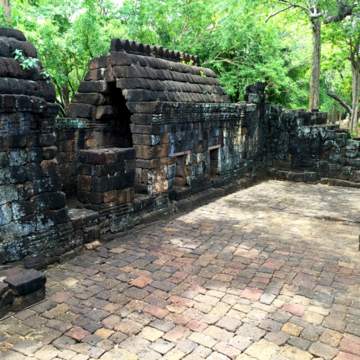

There’s an outer perimeter wall surrounding the entire structure of Monument 1. 
Low outer perimeter wall Note² Bodhisattva – an enlightened being, Avalokitesvara - "The Lord who looks down on the world" and one of great compassion, the deity is often described as radiating light over the universe. Monument 2 Monument 2 is a relatively simpler structure compared to Monument 1. It’s relatively flat as not much remains of the structure. 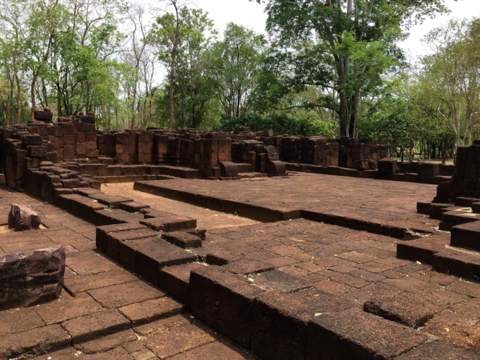
Monument 2 There are no deities here as they have been removed to the National Museum. There are only two gates in the low walls and the prang where the statue of the god is installed is located to the rear rather than the centre of the ruins. 
An empty pedestal Monuments 3 & 4, city walls We gave Monument 3 & 4 and the city walls a miss and moved on to the museum. Exhibition Hall These displays in the Exhibition Hall are replicas sculpted by local artisans; the originals are displayed in the National Museum in Bangkok. 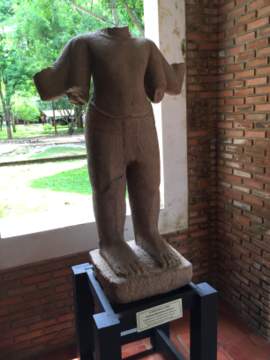
Radiating Bodhisattva Avalokitesavara 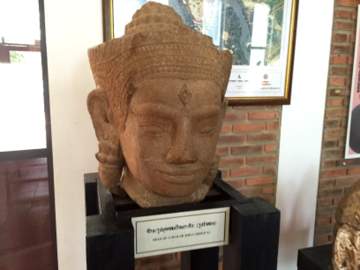
Head of Shiva 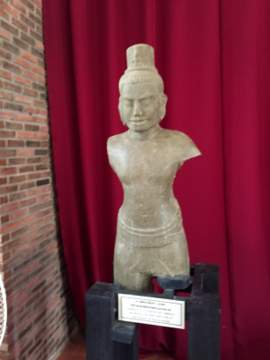
Prajnaparamita – a female goddess Stone Garden The displays in the Stone Garden are actually ornaments used in decorating the buildings in this sanctuary. 
Roof ornaments 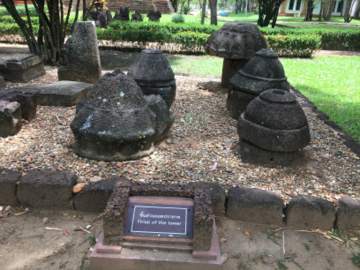
Tower ornaments 
Pedestals for religious statues 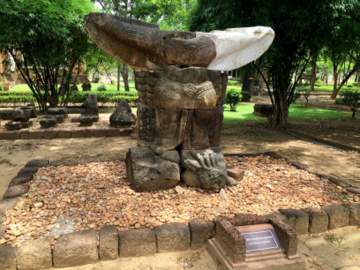
Sandstone garuda This sand model of Muang Sing Historical Park will give the visitor an idea of the extent of the monuments and their locations 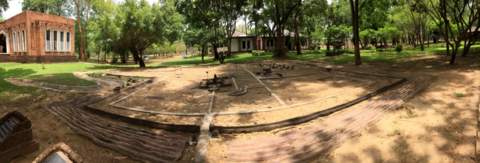
Sand model of Muang Sing Historical Park³ Note³ The view is from the east entrance, where the guard and ticket kiosks are located; the actual Exhibition Hall building is to the left. Monument 1 is in the centre of the model and the pre-historic burial site is to the left of the model, outside the walls. Table of contents Another historical discovery Having established that Muang Sing was built in the late 12th - early 13th C, it was not realised earlier that this historical site is located near something even older. In 1985, an officer from the historical park was clearing the grounds outside the old city walls near the banks of the Khwae Noi River when he found some old pots, beads, bronze artefacts and human bones! Five months later a survey uncovered a prehistoric burial in the area. In 1986, an excavation was done by the Archaeological Division of the Fine Arts Department. 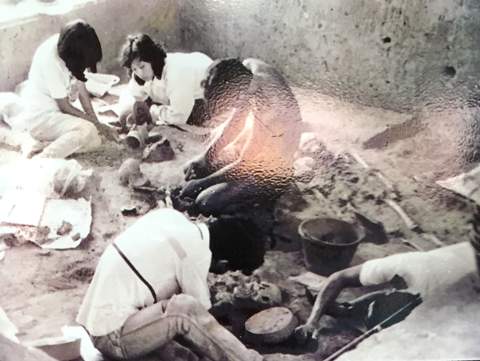
Excavation in Prasart Mueang Sing April – June 1986 It was indeed a prehistoric burial site. Four skeletons were discovered, two are retained here and the other two kept in the Ban Kao National Museum. The skeletons left in in Muang Sing consist of two females in their thirties buried with pots, bronze tools and wares, beads, bracelets and other ornaments. 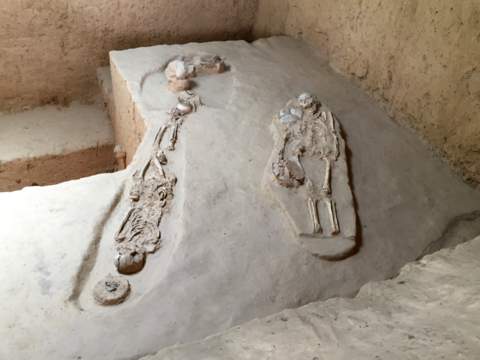
Two skeletons displayed in Prasart Muang Sing Historians believe that these remains belong to a culture that settled in the area around 1,500 – 1,000 BC, more than 3,000 years ago! 
Bronze and shell bracelets buried with the dead Given the historical nature of the Kanchanaburi area, who knows what further historical treasures will be found in the years to come. 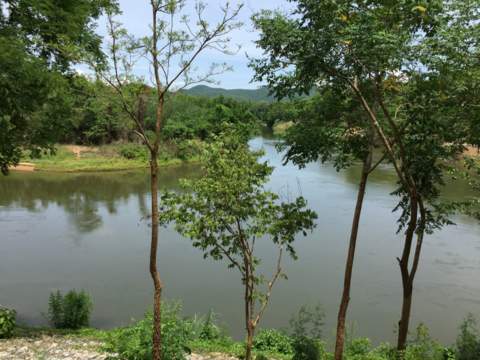
The peaceful and scenic Khwae Noi by the old burial site Table of contents Map to Prasart Muang Sing Click on this link for a bigger map How to get to Prasart Muang Sing From Bangkok get on to Boromarajajonani Road or Phet Kasem Road depending on which is more convenient for you. You will eventually join highway 4, Phet Kasem Road and hit Ban Pong, Ratchaburi. Continue on to highway 323 till you get to Kanchanaburi city. Drive through the city along Saeng Chuto Road. After you have left the city, turn left to re-join highway 323. Continue on highway 323 you get to the intersection with highway 3445. Turn left to highway 3445 and continue till you get to Prasart Muang Sing. This is a faster and more direct route than if you went by highway 3229/3445 through Ban Kao. Caution There’s a discrepancy between the numbering of the roads around Kanchanaburi city. In the Kanchanaburi city road signs and the Google map, Saeng Chuto Road which passes through the city is numbered 323 and the road bypassing the city is numbered 367. In the Thai highway maps, the road through the city is simply Saeng Chuto Road and the bypass road highway 323. Both roads eventually join up at the north-western edge of the city and continue onto highway 323. Opening hours Prasart Muang Sing is open every day from 0800 – 1700 hours. Admission fees Thai – 20 baht, foreigner - 100 baht Car – 50 baht Tuk tuk – 30 baht Motor-cycle – 20 baht Bicycle – 10 baht Address Muang Sing Historical Park Sing sub-district Sai Yok district Kanchanaburi 71150 Thailand Tel: +66 34 670 264 - 5 Table of contents
If you enjoyed reading this e-zine, please forward it to a friend. If you received this from a friend and found it interesting, please subscribe at Bangkok Travelbug. What do you think of the Bangkok Travelbug? We love to hear from you What other subscribers have said Till next month then. Eric Lim Tour Bangkok Legacies Find us on Facebook Copyright@2008-2015 Tour Bangkok Legacies All rights reserved |
| Back to Back Issues Page |